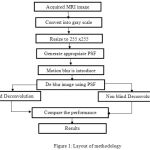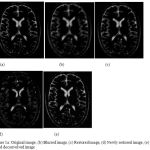Sugandha Agarwal1, O.P. Singh1 and Deepak Nagaria2
1Amity School of Engineering and Technology, Amity University, Lucknow.
2Electronics and Communication Department, BIET, Jhansi.
Corresponding Author E-mail: sugandhaa7@gmail.com
DOI : https://dx.doi.org/10.13005/bpj/1246
Abstract
For effectual analysis and diagnosis of medical images, image deblurring is the essential step. While acquiring, medical images usually get corrupted by noise and blur. The paper aims to improve the clarity and quality of blurred and noisy MRI (Magnetic Resonance Image) due to various causes such as Gaussian blurring, out of focus blur, motion artifacts, turbulence, and etc.Several procedures are available for denoising and deblurring image, but they lack uniqueness. Blind and non-blind deconvolution is utilized in this work to restore the original uncorrupted image. Deconvolution algorithms are analyzed both theoretically and experimentally for deblurring of MRI images. The performance evaluation is conducted using PSNR (Peak Signal to Noise Ratio), SNR (Signal to Noise Ratio) and MSE (Mean Square Error) on the basics of all the above mentioned parameters it was inferred that blind deconvolution algorithm produced more accurate result both analytically and experimentally.
Keywords
Blind deconvolution; Non- blind deconvolution; PSF (Point Spread Function); PSNR (Peak Signal to Noise Ratio); SNR (Signal to Noise Ratio) and MSE (Mean Square Error)
Download this article as:| Copy the following to cite this article: Agarwal S, Singh O. P, Nagaria D. Deblurring of MRI Image Using Blind and Non-Blind Deconvolution Methods. Biomed Pharmacol J 2017;10(3). |
| Copy the following to cite this URL: Agarwal S, Singh O. P, Nagaria D. Deblurring of MRI Image Using Blind and Non-Blind Deconvolution Methods. Biomed Pharmacol J 2017;10(3). Available from: http://biomedpharmajournal.org/?p=16296 |
Introduction
To acquire good quality and clear image is always a challenging task. Therefore development of new and improved techniques for degradation always attract the researchers.1 Diagnosis through digital imaging scheme plays a dominant role in medical research, clinical practices, etc. Usually medical images such as MRI, CT scan, and X-ray are contaminated while measuring due to unknown disturbance (arising due to noise or blur) caused due to motion artifacts.2,3 Image deblurring has many application across a large number of areas, ranging from medical imaging, microscopy,4 remote sensing5 and planetary imaging. For removing blur and noise from medical images various algorithms are proposed. Many method for blind deconvolution have been proposed but with one or other drawbacks.6 Basic shortcoming of earlier proposed techniques are they lack to procure the original details of the acquired images.7
Recursive soft decision approach for blind deconvolution was proposed by Kim hui yap and Ling Gaun,8 in which deconvolution is achieved by soft decision blur identification and hierarchical neural network. Through which limitation of hard decision method are overcome by providing a continual soft decision blur adaption according to best fit parametric structure. Molina and Katsaggelos9 have proposed a Varitional Bayesian image restoration method10,11 and.12 This method uses product of spatially13 weighted total variation image priors having capability of capturing local image features.14 Jian-Feng Cai, Hui Ji, Chaoqiang Liu, and Zuowei Shen proposed a new optimization approach,15 mixed regularization strategy for the blur kernel to eliminate complex motion blurring from a image by bring together new sparsity-based regularization terms on both images and motion-blur kernels.13 Reconstructing focused images using filtering approach was proposed by Akira Kubota and kiyoharu aizawa16 in which degree of blur is directly and arbitrarily manipulated.
In blind deconvolution method sharp version of the image is restored, without knowing the source of blurring and details of the clear image. Whereas in non-blind deconvolution blurring source and clear image is known while restoring sharp version of image. Blind deconvolution approach is more suited for practical scenario.17 As in real imaging world while acquiring image our image is corrupted by unknown parameter which can be Gaussian noise, atmospheric turbulence, motion blur, etc. The image capturing process is usually modeled as the convolution of a blur kernel h with an ideal sharp image f, plus some noise n:
g = h ⊗ f + n: (1)
g is the realization of a random array with probability distribution resolute by the ideal image f and kernel h.
In this work, firstly degradation model is described and the shortcomings of deconvolution is addressed. MRI images obtain are usually noisy or blurred. Therefore mechanism for denoising or deblurring is required. For deblurring PSF is necessary factor to be considered.18 Both the deconvolution models i.e. Blind deconvolution and Non Blind deconvolution performance is analyzed and compare with the help of performance parameters such as SNR, MSE and PSNR. Then after methodology adopted with simulation results and conclusion is discussed.
Image Deconvolution Methods
Blind Image Deconvolution
In blind deconvolution, deblurring of image is achieved without known point spread function. When image is acquire from the camera, it is actually a depiction of what you actually see from your naked eye. Trying to reconstruct the original image and the point spread function11 from a camera acquired image is called blind image deconvolution.2,3
Mathematically, we wish to decompose a blurred image y as:
y = k ⊗ x
Where x is a visually possible sharp image and k is a non-negative blur kernel
Non-Blind Deconvolution
Image deconvolution tries to obtain a sharp image f having as input a blurred version g, and possibly a convolution kernel h. If h is available, the process is called non-blind deconvolution.2,3
Mathematically represented as:
g = h⊗ f + n;
Methodology Adopted
Methodology adopted for the deblurring uses blind and non-blind deconvolution algorithm. For which first, MRIscan of brain was acquired, then it was converted into grayscale and resizing of image is performed. As the size of image and type of blur in the image is the major constraint while deblurring the image. MRI image is resize to 255 x 255 pixel size. To obtain blur free image when PSF is unknown, blind deconvolution technique is utilize to produce noise free, blur free image. Whereas when PSF is known several non-blind deconvolution techniques are proposed. Usually commonly available method for deblurring utilizes non blind deconvolution technique for deblurring as it is less complex. But as we know that in practical situations type of noise and blur is not known. For finding PSF appropriate for original image in our work weighted array method is incorporated. PSF describes the degree to which system blurs a point of light. PSF can be undersized or oversized depending on the type of blur and requirement.
For deconvolution known Gaussian blur was introduced on the original resize image. After which blind and non- blind deconvolution method is applied on the original and blurred image. For performance evaluation and comparison of both the methods, performanceparameter such as Peak Signal to Noise Ratio (PSNR), Signal to Noise Ratio (SNR) and Mean Square Error (MSE) are computed.
 |
Figure 1: Layout of methodology
|
Simulation Result and Discussion
Image deblurring is basically the deconvolution of degraded image with the point spread function (PSF) that exactly describe the distortion. In degradation model firstly original input image is blurred or degraded through convolution with a Low pass filter, Gaussian filter is used which blur the original input image. Then after blind and non-blind deconvolution methods are applied and performance parameters SNR, PSNR and MSE are calculated. By analyzing the results we infer that blind deconvolution produces higher SNR and PSNR indicating more signal information, and lower MSE indicating less amount of error.
 |
Figure 1a: Original image, (b) Blurred image, (c) Restored image, (d) Newly restored image, (e) Non blind deconvolved image
|
Table 1: Table showing SNR, PSNR, MSE of different images
| SNR | PSNR | MSE | |
| Original Image | 18.434 | 33.416 | 30.535 |
| Blurred image | 13.93 | 33.66 | 51.25 |
| Image after blind deconvolution | 20.19 | 33.56 | 22.38 |
| Image after non blind deconvolution | 14.90 | 33.39 | 45.82 |
 |
Figure 2: Graphical representation of results
|
Conclusion
In this paper a comprehensive understanding of image Deblurring technique based on Blind and non-blind Deconvolution Method are detailed. The Proposed techniques were compared for deblurring the blurred MRI image to obtain original undistorted image. Both blind and non-blind deconvolution aims to reconstruct the blurred image, blurring phenomenon can occur due many conditions such as Gaussian blur, motion artifacts, camera misfocus, etc. The result obtained by proposed techniques infers that blind deconvolution approach is more suitable and appropriate both practically and experimental. From the simulation resultwe found that the blind deconvolution approach provides the better results in restoring the original MRI image from blur image. For blind deconvolution method we obtained higher PSNR and SNR value compared to that of non- blind deconvolution method, which indicates improved quality of image as depicted in table 1. MSE value for blind deconvolution is also lesser than other method, which signifies small error is present in the reconstructed image.
References
- Banham M and Katsaggelos A. Digital image restoration. Signal Processing Magazine. IEEE 1997;14(2):4-41.
CrossRef - Campisi P and Egiazarian K. Blind Image Deconvolution: Theory and Applications. CRC Press. 2007.
CrossRef - Stockham G., Jr. Cannon T. M and Ingebretsen R. B. Blind deconvolution through digital signal processing. Proceedings IEEE. 1975;63(4):678–692.
CrossRef - Sibarita J. B. Deconvolution microscopy. Adv. Biochemistry. Eng.Biotechnology. 2005;95:201-243.
CrossRef - Starck J. L., Pantin E and Murtagh F. Deconvolution in astronomy: A review. Publications of the Astronomical Society of the Paci_c (October). 2002;1051-1069.
CrossRef - Agarwal S., et al. Analysis of linear filtering techniques on X-Ray image.Computer and Communication Technology (ICCCT), 2014 International Conference on. IEEE. 2014.
- Agarwal S., Singh O. P., Nagaria D. Analysis and Comparison of Wavelet Transforms for Denoising MRI Image. Biomed Pharmacology J. 2017;10(2).
- Yap H., Guan L and Liu W. A recursive soft-decision approach to blind image deconvolution. IEEE Trans. Signal Process. 2003;51:2.
CrossRef - Mateos J. M and Katsaggelos A. Blind deconvolution using a Varitional approach to parameter, image, and blur estimation. IEEE Transactions on Image Processing. 2006;15(12):3715–3727.
CrossRef - Chantas G., Galatsanos N. P., Molina R., Katsaggelos A. K. Varitional Bayesian image restoration with a product of spatially weighted total variation image priors. IEEE Trans on image processing. 2010;19:2.
CrossRef - Galatsanos N. C.,Likas A and Saunders M. Varitional Bayesian image restoration based on a product of t-distributions image prior. IEEE Trans. Image Processing. 2008;17:1795–805.
CrossRef - Chantas K., Galatsanos N. P and Likas A. Bayesian restoration using a new nonstationary edge-preserving image prior. IEEE Trans. Image Processing. 2006;15:2987–2997.
CrossRef - Cannon. Blind deconvolution of spatially invariant image blurs with phase. IEEE Transactions on Acoustic, Speech and Signal Processing. 1976;24(1):58–63.
CrossRef - Agarwal S., et al. Encrypted Image Denoising using Adaptive Weighted Median Filter.Indian Journal of Science and Technology. 2017;10(18).
CrossRef - Cai J. F., Ji H., Liu C., Shen Z. Frame let-Based blind motion deblurring from a single image. IEEE trans on image processing. 2012;21:2.
- Kubota A., Aizawa K. Reconstructing arbitrarily focused images from two differently focused images using linear filters. IEEE trans on image processing. 2005;14:11.
CrossRef - Bishop E and Hopgood J. R. Blind image restoration using a block- stationary signal model in ICASSP. IEEE International Conference on Acoustics, Speech and Signal Processing Proceedings. 2006.
- Chang S., Yun S. W and Park P. PSF search algorithm for dual-exposure type blurred image.Int. Journal of Applied Science, Engineering and Technology. 2007;4.








